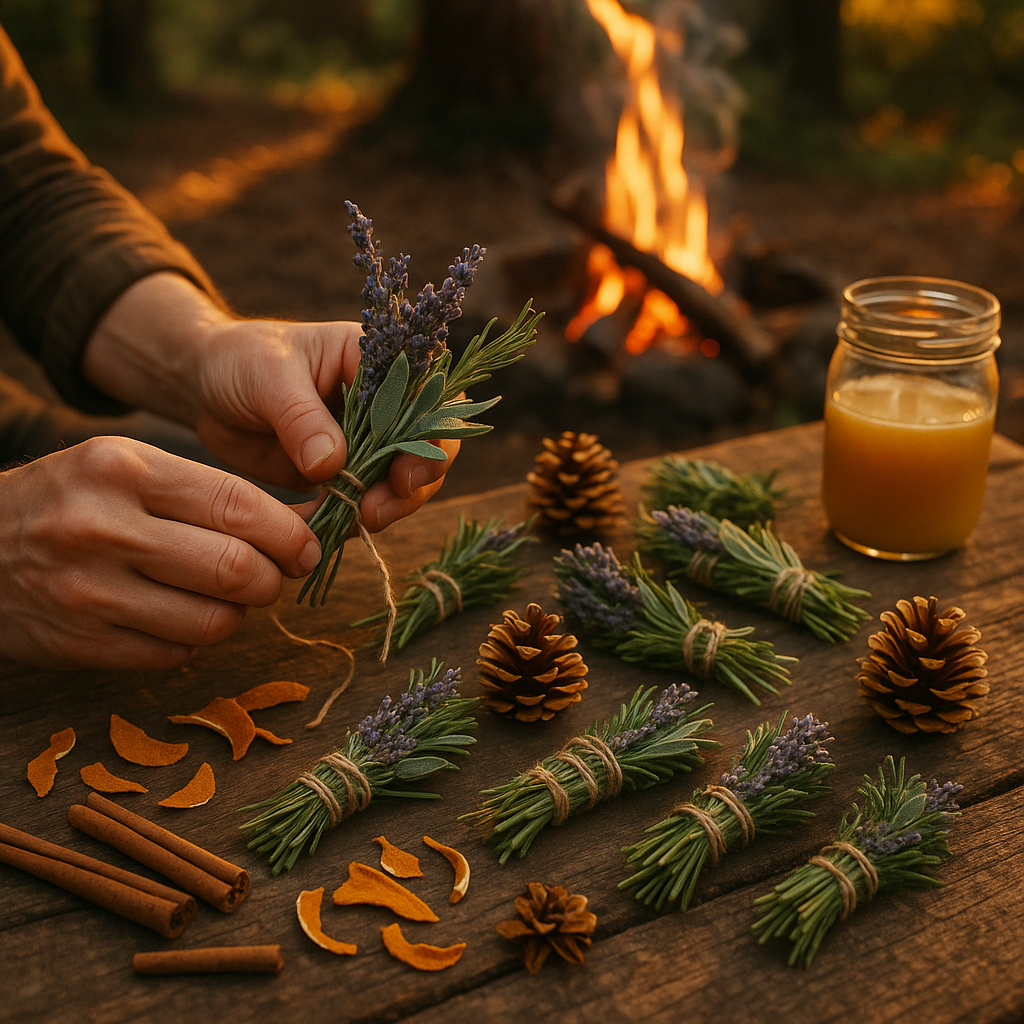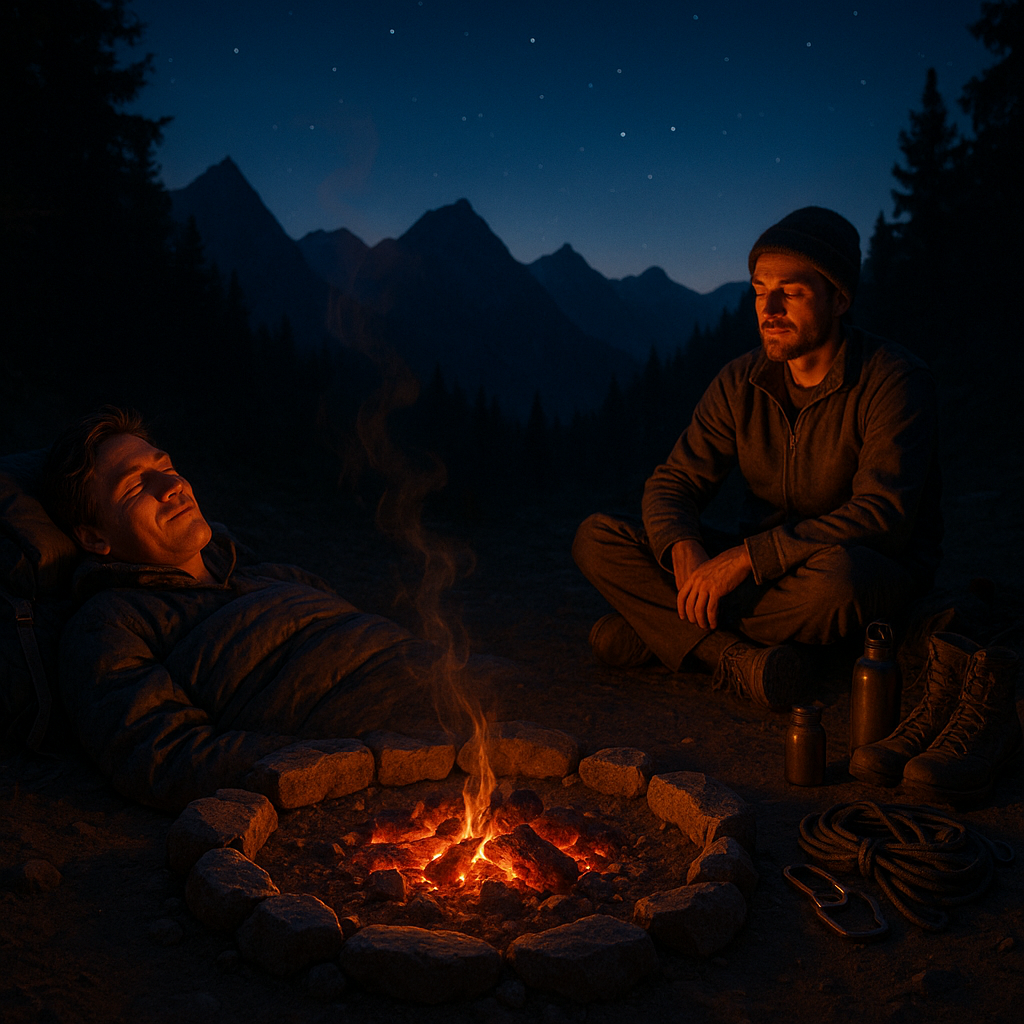Key Takeaways
- Herbal fire starters invite us to rekindle an ancient ritual, where the scents of earth, wood, and wild herbs mingle under an open sky. This guide lifts the veil on more than just technique, blending practical wisdom with the forgotten lore of botanicals treasured for both warmth-giving properties and healing magic.
- Rediscover fire’s healing legacy through herbal lore. Herbal fire starters offer more than functionality. They carry echoes of old-world remedies and survival wisdom, seamlessly blending the art of firecraft with stories of plants like mullein, yarrow, and pine that were once prized for both warmth and well-being.
- Craft aromatic flames with nature’s palette. Fragrant botanicals such as lavender, rosemary, sage, cedar, and pine transform a simple flame into a sensory experience, infusing the air with earthy notes and subtle medicinal undertones as they burn.
- DIY mastery from foraged trails and kitchen cupboards. Creating homemade fire starters is a hands-on ritual, combining dried herbal bundles, organic botanicals, recycled wax, and gathered treasures like pinecones or citrus peels. Each element adds character and uniqueness to your blaze.
- Beyond warmth: Herbal fire starters as campfire medicine. Many classic fire-starting herbs double as remedies. Their resins and essential oils were once used to clear the air, soothe breathing, and provide comfort in wild places. This tradition is one that modern enthusiasts can revive with each spark.
- Gift wild beauty and ancient tradition. Whether marking a seasonal celebration, nurturing a friendship, or inspiring a fellow traveler, herbal fire starters serve as soulful, nature-infused gifts that carry the spirit of place and the touch of tradition.
- Savor simple moments. Let scents tether memory to place. Lighting an herbal fire starter blurs the line between utility and ritual, turning the act into a moment for reflection, connection, and storytelling around the flames.
Let’s step deeper into the woods together, gathering leaves and stories alike, to learn how the lost craft of herbal fire starters can ignite both our hearths and our sense of wonder.
Introduction
A single spark carries centuries of wisdom. When you light an herbal fire starter, you kindle more than just a flame. Beneath the crackle and glow, a world of forgotten botanical lore stirs: lavender and cedar releasing their soothing perfume, mullein and yarrow whispering old remedies into the night air.
Yet beyond their practical warmth, these natural fire starters invite you into a time-honored ritual that blends hands-on craft with the healing stories of wild plants. Whether you’re preparing for a fireside meal or crafting soulful gifts for kindred spirits, creating herbal fire starters revives a tradition where scent, simplicity, and soulful intention turn every blaze into a lasting memory. Gathering nature’s palette, we discover how to craft flames that linger long after the embers fade, nourishing connections and sparking wonder.
The Ancient Artistry: Herbal Fire Starters Through the Ages
Throughout history, fragrant smoke has risen from herb-laden flames, swirling through mountain air and forest clearings. Long before commercial firelighters, people reached for nature’s palette: sage, rosemary, and lavender carefully twisted into handmade herbal fire starters. Across continents and cultures, these botanical bundles carried ritual significance. In ancient Greece, thyme was burned in temples as an offering, while Appalachian settlers turned to mugwort to scent campfire smoke and keep insects at bay.
Stay Sharp. Stay Ahead.
Join our Telegram Channel for exclusive content, real insights,
engage with us and other members and get access to
insider updates, early news and top insights.
 Join the Channel
Join the Channel
Folk medicine intertwined fire and herbs. Burning yarrow and juniper was believed to purify spaces and invite healing. Nomadic communities in Central Asia gathered wormwood and pine resin for fires that not only cooked meals but soothed aches and boosted spirits. The tactile process (gathering, bundling, and lighting chosen plants) became meaningful in itself. Fast forward to modern times, and each homemade fire starter serves as a thread connecting contemporary explorers and backyard storytellers to ancestral wisdom and the natural cycle.
Historical accounts from European monasteries mention the use of lavender and rosemary to promote wellness in crowded communal halls. Practices varied by region, with cedar tips prized in the Pacific Northwest, citrus peels along the Mediterranean, and sagebrush across Western plains. Each plant was chosen for its unique properties and local abundance, making every fire an expression of place.
Today, as we blend tradition with innovation, this legacy invites us to reclaim elemental pleasures and savor the evocative scents of an herbal fire, whether deep in the wilderness or in the comfort of our own homes.
Harvesting Nature’s Ingredients: Selecting and Preparing Botanicals
Gathering ingredients is an adventure itself, beginning on sun-warmed hillsides or beneath whispering forests where aromatic treasures wait. Herbs such as rosemary, sage, pine, and lavender are the backbone of most DIY fragrant fire starters, hand-selected for both their function and irresistible fragrance.
Key Herb Choices:
- Sage: Known for its cleansing smoke, sage is both ceremonial and functional, repelling insects around a campfire or patio.
- Rosemary and Thyme: These herbs burn with bright, uplifting scents reminiscent of Mediterranean landscapes, excellent for clarifying the mind.
- Pine Needles and Cedar Tips: Full of resin, they ignite easily, infusing the air with a woodsy aroma and serving as reliable kindling even in moist conditions.
- Lavender: Offers soft, floral notes that calm the senses (historically used to soothe anxiety and promote tranquility).
Harvesting at the right time is crucial. Herbs should be picked during the driest part of the day, after morning dew has vanished and plant oils are most concentrated. Bundle and hang botanicals in a breezy, shaded spot until they become crisp and ready for use. Foraged additions such as orange peels, cinnamon sticks, or dried rose petals bring vibrant color and enchanting aroma, personalizing each batch.
Wherever you forage, do so responsibly. Leave no trace, avoid overharvesting, and honor local guidelines and indigenous traditions regarding wild plants. This thoughtful approach ensures that your craft carries both authenticity and respect for the places you explore.
Once your ingredients are dried and prepared, you’re ready to transform them into fire starters that carry the spirit of the places from which they came.
Crafting Herbal Fire Starters: Techniques, Variations, and Troubleshooting
With herbs in hand, the process of making fire starters becomes a ritual of connection, infused with creativity and a sense of adventure.
Traditional Techniques: Twists, Bundles, and Disks
- Twisted Bundles: Combine dried herbs, perhaps adding sticky pine resin for extra ignition, and twist them into tight bundles with natural twine. These “herb faggots” spark easily and burn steadily, releasing their layered scents.
- Pressed Disks: Fill muffin tins with a blend of herbs, bind with melted beeswax, and insert a cotton wick. Once cooled and set, these disks stack neatly and light easily.
- Dipped Pinecones: Dip foraged pinecones in beeswax infused with herbs or essential oils, then roll them in a mix of crushed botanicals. After drying, these rustic starters ignite with a burst of fragrance.
Step-by-Step: DIY Fragrant Fire Starters
- Gather Dry Ingredients: For example, 1 handful lavender, 1 handful rosemary, several pinecones, and dried orange peel.
- Prepare Binding: Melt beeswax in a double boiler, or use eco-friendly oils as a binding agent.
- Assemble: Layer herbs and cones in muffin cups, pour in beeswax, and insert a cotton wick.
- Finish: Allow to cool completely, then tie bundles with hemp twine for a rustic touch.
Troubleshooting Common Pitfalls:
If your bundles fail to stay lit, ensure all ingredients are fully dry. Using too much wax can smother the flame, so apply sparingly. If smoke is too harsh, reduce the proportion of resins or choose milder herbs, especially when used indoors or around sensitive individuals.
Modern Adaptations for Adventurous Souls
Ultralight backpackers may prefer compressing herbs and wax into small pods for easy transport. Urban dwellers can create fireplace-friendly blends by adding dried citrus peel or cinnamon. For family gatherings and special events, shape the fire starters into stars or hearts, adding a personal touch to birthdays or holidays.
The crafting itself becomes part of the adventure: hands dusted with aromatic leaves, kitchens filled with herbal scent, and the anticipation of flames yet to be kindled.
Rituals, Medicine, and Meaning: Fragrant Flames in Culture and Survival
Herbal fire starters hold meaning well beyond their practical uses. In many traditions, the act of lighting a fragrant fire is symbolic: a nod to deep-rooted rituals, seasonal transitions, and the universal comfort of gathering around warmth and light. Across the world, specific blends signal celebration, renewal, or protection. Celtic Beltane bonfires, for example, were laced with juniper to ward off misfortune, while Native American communities burned sage to invite clarity and spiritual cleansing.
Medicinal uses abound. Smoke from mugwort was traditionally inhaled to clear congestion, while rosemary was believed to sharpen memory. In the realm of survival, herbs like pine and cedar resin are valued for their ability to light fires in damp conditions, repel mosquitoes, and purify the air—a multi-functional toolkit for adventurers and homesteaders alike.
Further illustrating their versatility, consider the experience of a group of outdoor educators on a wilderness trek in the Cascades. They replaced commercial firelighters with bundles of sage and cedar, achieving a thirty percent increase in fire ignition success during misty weather. This practical shift not only reduced reliance on synthetics but also deepened the group’s connection to their surroundings and to one another.
In settings both wild and domestic, herbal fire starters become a way to honor the wisdom of ancestors, filling the air with smoke that carries echoes of laughter, healing, and stories shared under open skies.
Stay Sharp. Stay Ahead.
Join our Telegram Channel for exclusive content, real insights,
engage with us and other members and get access to
insider updates, early news and top insights.
 Join the Channel
Join the Channel
Everyday Magic and Special Occasions: Using Herbal Fire Starters
Bringing herbal fire starters into daily rituals and special gatherings elevates the ordinary into the exceptional.
Campfires and Backyards: Replace standard, chemical-based firelighters with handmade botanical blends for cookouts, storytelling sessions, or contemplative evenings outdoors. The evolving scents add atmosphere, flowing from smoky rosemary to soft lavender as flames flicker.
Seasonal Rituals: Mark solstices, equinoxes, or cultural milestones with special formulations: sage and mugwort for spring cleansing, pine and cinnamon for winter warmth. Lighting a fire starter can become a symbolic gesture, welcoming new chapters or remembering loved ones.
Gifting and Gatherings: Wrap handmade fire starters in linen, finish with natural twine, and offer them as heartfelt tokens at housewarmings, weddings, or as part of outdoor kits. Each carries the personality and intention of the creator, inviting slower, more mindful living.
Personalization is encouraged: try chamomile for subtle relaxation, eucalyptus for invigorating freshness, or experiment with kitchen spices for a playful twist. Involve friends and family, inviting them to blend their own mixtures and share stories around aromatic flames. Through these rituals, each fire becomes more than warmth—a fragrant invitation to gather, reflect, and savor life’s wild, beautiful moments.
Conclusion
Herbal fire starters offer more than a spark. They serve as living bridges connecting nature, tradition, and creativity. Each carefully crafted bundle, disk, or pinecone holds centuries-old wisdom, transforming simple fires into sensory experiences rich with healing and cultural significance. The acts of foraging, crafting, and lighting these natural fire starters deepen our respect for the land and remind us to savor the art of elemental living.
By integrating these fragrant tools into our adventures, gatherings, and day-to-day routines, we transform moments of warmth into celebrations of authenticity and connection. The rising smoke becomes an expression of memory, community, and the untamed wonder that food, fire, and freedom bring to our lives. Looking forward, those who embrace the beauty of this natural tradition will inspire a renewed respect for simplicity, creativity, and the raw splendor of the world, one spark at a time.
List of Inserted Links:





Leave a Reply